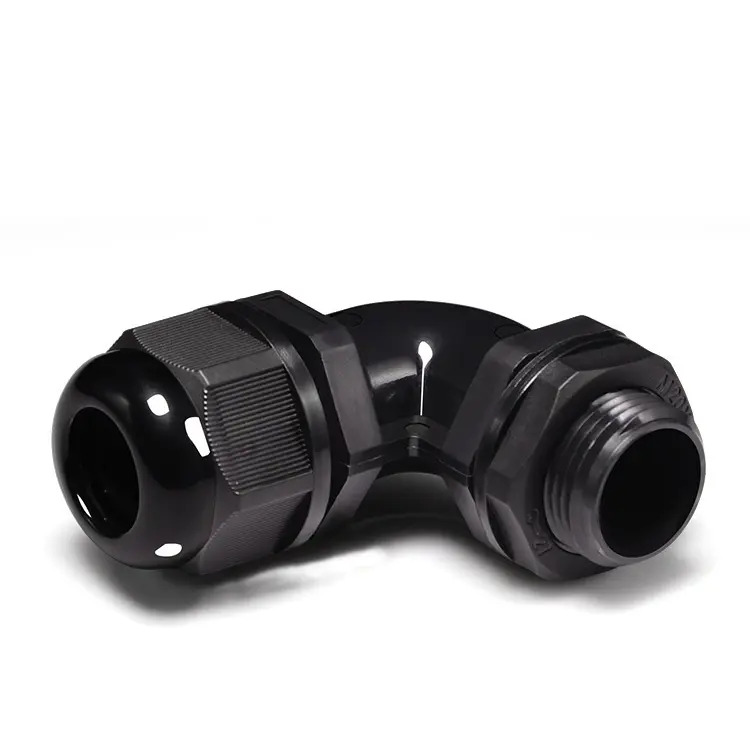Elbow Cable Gland: A Crucial Component for Secure and Efficient Cable Management
2025-05-13
In modern electrical and electronic systems, effective cable management is essential for ensuring both safety and performance. One component that plays a pivotal role in cable management, particularly in environments with limited space or challenging angles, is the elbow cable gland. Designed to provide a secure and reliable connection between cables and electrical equipment, elbow cable glands offer a unique solution for managing cables in tight spaces or at angles. This article explores the features, benefits, and applications of elbow cable glands.

What is an Elbow Cable Gland?
An elbow cable gland is a specialized fitting used to connect cables to electrical devices, equipment, or panels while providing protection against external factors such as moisture, dust, and mechanical stresses. The key distinguishing feature of an elbow cable gland is its angled design, which allows the cable to enter the equipment at a 90-degree angle. This design makes elbow cable glands ideal for situations where space is constrained or where cables need to be routed in specific directions.
Elbow cable glands are typically made from robust materials such as brass, stainless steel, or durable plastic, which are resistant to corrosion, chemical exposure, and wear. The gland is designed to provide a tight, secure seal, preventing the ingress of environmental elements while also ensuring that the cable remains firmly attached to the equipment.
Key Features of Elbow Cable Glands
1. 90-Degree Angle:
The most notable feature of an elbow cable gland is its 90-degree angled entry. This allows cables to be routed along a specific path, making it easier to navigate tight spaces or areas where straight cable entry is not feasible. It provides more flexibility in cable management, especially in compact enclosures.
2. Sealing and Protection:
Elbow cable glands are equipped with sealing mechanisms that prevent dust, dirt, moisture, and other environmental contaminants from entering the equipment. This is particularly important in industrial and outdoor environments where exposure to these elements could damage sensitive components.
3. Durable Materials:
Typically made from materials such as brass, stainless steel, or high-quality thermoplastic, elbow cable glands are designed for durability. These materials ensure long-term performance, resistance to corrosion, and the ability to withstand harsh environmental conditions.
4. Cable Strain Relief:
An essential feature of elbow cable glands is their ability to provide strain relief. The gland ensures that the cable is securely anchored to the equipment, preventing any tension or strain from being transferred to the cable itself, which could lead to damage or malfunction.
5. Versatility:
Elbow cable glands are available in various sizes and configurations to accommodate different types of cables. Whether you are working with power cables, data cables, or multi-core cables, there is an elbow cable gland designed to meet the specific requirements of the application.
6. Easy Installation:
Most elbow cable glands are easy to install, featuring user-friendly designs that allow for quick and hassle-free assembly. With the right tools, professionals can install these glands without the need for specialized skills, making them suitable for both DIY and professional use.
Benefits of Using Elbow Cable Glands
1. Space Efficiency:
In many electrical installations, especially those in confined spaces such as cabinets, junction boxes, or industrial control panels, space is often limited. The 90-degree design of elbow cable glands helps to save valuable space while still providing the necessary protection and cable routing capabilities.
2. Enhanced Cable Protection:
By providing a secure seal, elbow cable glands protect cables from external factors such as moisture, dust, oils, chemicals, and physical damage. This helps extend the life of the cables and ensures the safety and efficiency of the electrical system.
3. Improved Safety:
With the added strain relief feature, elbow cable glands prevent accidental disconnections or cable damage due to mechanical stress. This enhances the overall safety of the electrical system, reducing the risk of electrical failures or hazards.
4. Customization Options:
Elbow cable glands can be customized to suit a wide variety of applications. They are available in different materials, sizes, and thread types, ensuring compatibility with various cables and electrical enclosures. Whether the application involves high-voltage, low-voltage, or high-temperature environments, there is an elbow cable gland suitable for the job.
5. Weather Resistance:
In outdoor or rugged environments, the weatherproof properties of elbow cable glands are crucial. They are designed to withstand extreme weather conditions, including exposure to UV rays, rain, or high temperatures, ensuring that cables remain protected no matter the external conditions.
6. Cost-Effective Solution:
The combination of long-term durability, minimal maintenance requirements, and ease of installation makes elbow cable glands a cost-effective choice for cable management. By preventing cable wear and reducing the need for frequent replacements, they provide value over time.
Applications of Elbow Cable Glands
1. Industrial and Manufacturing:
In industrial settings where machinery and electrical panels are often compact or positioned at odd angles, elbow cable glands are essential for ensuring safe and secure cable connections. They provide a reliable solution for protecting cables while maintaining efficient cable routing.
2. Outdoor Installations:
Elbow cable glands are frequently used in outdoor electrical installations, such as street lighting, telecommunications equipment, and utility boxes. Their ability to create a weatherproof seal ensures that cables remain protected from environmental elements.
3. Control Panels and Junction Boxes:
These glands are commonly found in control panels, junction boxes, and electrical cabinets. The ability to direct cables at a 90-degree angle allows for neat and organized wiring, reducing clutter and enhancing accessibility.
4. Automotive and Transportation:
In the automotive and transportation industries, elbow cable glands are used to protect cables in vehicles and machinery, where space is often limited. They ensure that cables remain securely in place, reducing the risk of damage during movement or vibrations.
5. Marine Applications:
For marine vessels, where exposure to saltwater and corrosive elements is a concern, elbow cable glands offer the ideal solution. Their corrosion-resistant properties make them perfect for use in harsh marine environments, ensuring the safety and reliability of electrical systems.
Conclusion
Elbow cable glands are an essential component for efficient and secure cable management, especially in applications where space constraints or specific routing requirements exist. Their durable construction, sealing capabilities, and ease of installation make them ideal for a wide variety of industries, including manufacturing, outdoor installations, automotive, and marine applications. By providing protection against environmental factors and ensuring a secure connection, elbow cable glands play a crucial role in enhancing the reliability and safety of electrical systems. Whether you're working with industrial machinery, control panels, or outdoor wiring, elbow cable glands offer a versatile, long-lasting solution to your cable management needs.


